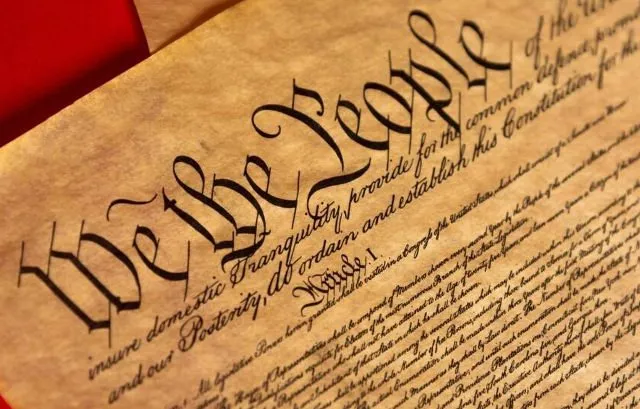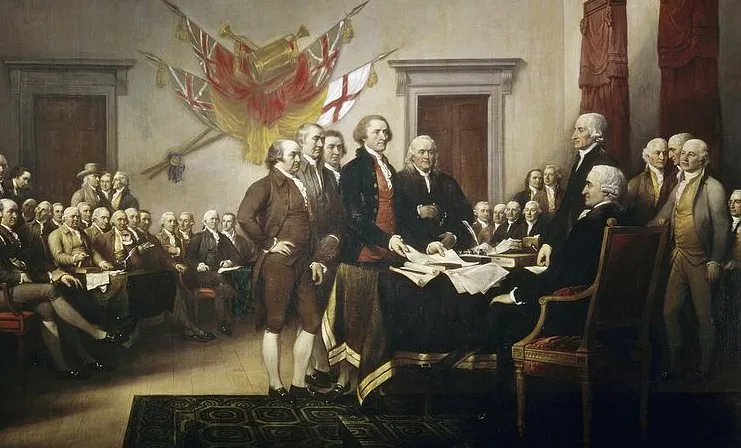
People who revere “the Founders” and the U.S. Constitution have massive internal contradictions in their heads. (So did I, back when I did that.) I’m not saying that such people are bad, or stupid, but I am saying that they have been taught to feel religious devotion to a hodge-podge of self-contradictory ideas that have been twisted, misrepresented and deified. The purpose of this article is to separate the genuinely wise and virtuous bits and pieces of thought from Revolutionary days, from the authoritarian mythology which contaminated and perverted those ideas into something anti-freedom and anti-human. Of course, people who feel deep emotional reverence for such things are likely to be made uncomfortable by this article, just as I was uncomfortable when I started to examine my own loyalty to and love for the Constitution many years ago.
For starters, as I often point out, “the Founders” did not all believe the same thing. Though they may get lumped together a lot, there were major, fundamental differences, philosophically and tactically, among the different individuals now referred to as “Founders.” The most obvious divide was between the federalists and the anti-federalists.
In all the flag-waving, constitution-worshiping propaganda I was subjected to when younger, I don’t recall anyone ever mentioning to me the fact that two of most prominent characters of the Revolutionary days—Patrick Henry and Thomas Paine—were both ardent and vocal opponents of the U.S. Constitution, predicting (and rightly so) that it would create an authoritarian monster that would quickly become even worse than a king. For a crash course in some of the major disagreements, watch this:

It’s worth mentioning that the Soviet Union, communist China, and North Korea (among others) also had constitutions, creating democratically-elected republican “governments,” which also were theoretically limited by a “bill of rights” in each constitution. But while Americans have no problem seeing through the thinly veiled charades of those regimes being about serving and representing the people, while protecting the rights of the individual, they still believe the very similar—and equally false—mythology that they were taught about the U.S. Constitution. So let’s consider a few issues and concepts, and compare the mythology to the reality, regarding the origins of this country.
1 - “The Declaration of Independence and the U.S. Constitution are the two greatest documents ever written!”
Just as “the Founders” tend to get lumped together, the Declaration and the Constitution tend to get lumped together, even though they expressed drastically conflicting ideas. In short, the Constitution was a massive betrayal and perversion of the ideas expressed in the Declaration. In fact, other than the false assertion that “governments are instituted among men” in order to secure and protect individual rights, the Declaration is almost an anarchist document. It basically says that if “government” does anything other than protect individual rights, the people should change it or get rid of it. (What they got wrong was the notion that “government” could ever be a legitimate protector, without being a parasitical aggressor.)

Between the signing of the Declaration, and the ratification of the Constitution, how did we get from the idea that all people have equal rights (the Declaration) to the idea that some people have the right to rob (“tax”) everyone else (the Constitution)? And how did we get from the idea that the people have the right, and the duty, to “alter or abolish” any “government” which becomes destructive of individual rights (as it says in the Declaration), to a situation where a centralized authoritarian ruling class has the right to call out the militia to “execute the Laws of the Union” and to “suppress Insurrections” (as it says in the Constitution)?
In short, the Declaration said that “government” should only protect individual rights, while the Constitution pretended to create a new ruling class and “authorized” it to violate the rights of individuals in various ways.
2 - “The Constitution was made to limit government!”
There are two ways in which this statement is patently false. First of all, both the federalists and the anti-federalists, when the constitution was under debate, agreed that the entire purpose of the new constitution was to strengthen and expand central “authority,” as compared to the situation that existed under the “Articles of Confederation,” which was basically just a pact between state “governments,” where there really was no national “government” with any real power of its own.

Secondly, the U.S. Constitution pretended to create a legitimate ruling class, and claimed to give the new centralized political “authority” a number of new powers. At the insistence of the anti-federalists, and over the objections of the federalists, provisions were eventually added to the original version (added in the form of the “Bill of Rights”) in an effort to limit those powers. (Below we’ll get to how and why those “limits” utterly failed.) But to say that the true purpose of the document which created the power to begin with was actually to limit political power is nonsensical.
It’s analogous to putting a bomb in your living room, putting some pillows around it, and then saying that the purpose of the bomb is to protect people from being blown up. You might want to argue that the purpose of adding the pillows was to protect people from the blast (even if such a plan is misguided and ineffective), but to say that the bomb is there to protect people is just absurd. Similarly, to say that limiting political power was the primary purpose of a document which created a ruling class is logically ridiculous.

(In Part 2 of this article (https://steemit.com/anarchy/@larkenrose/constitutionalists-1-1-3-part-2-of-2), we will look at more of the wisdom, and more of the lunacy, which was expressed in Revolutionary days.)
(Larken Rose is a speaker, author and activist, having advocated the principles of non-aggression, self-ownership and a stateless, voluntary society for over twenty years. Donations to help support his articles, videos and other projects can be made by PayPal to "larken@larkenrose.com" or by Bitcoin to 13xVLRidonzTHeJCUPZDaFH6dar3UTx5js.)